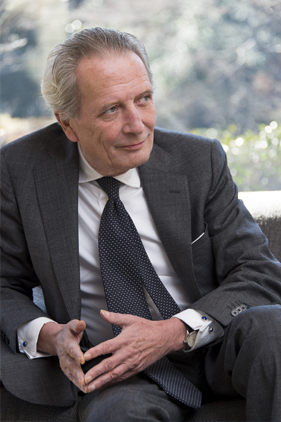June 2016, Year VIII, no. 6
Domenico Giorgi
Bewitched by ‘Il Bel Paese’
“You’re right, Italy and Japan have very similar economies. They both have solid manufacturing industries that generate roughly 20% of their GDP thanks to the enormous number of SMEs in both countries. We are still, as they used to say, industrial giants.”
Telos: 150 years of friendship. In 1866 Italy and Japan signed the Treaty marking the start of diplomatic relations; this year the two countries celebrate the 150th anniversary of the Treaty. Could you briefly outline the history of this friendship between Japan and Italy?
Domenico Giorgi: A few years after Japan opened to the West in 1854, Italian silk producers and traders were the first to trigger relations between the two countries. They went to Japan to obtain raw material undamaged by the pébrine disease that had decimated silkworm breeding farms in Europe. This was the situation when on 25 August 1866 the Friendship and Trade Treaty was signed between Italy and Japan in Edo (Japan), officially marking the beginning of bilateral diplomatic relations. Since then collaboration between the two countries has gone from strength to strength. Shortly after the signing of the Treaty, a few dozen entrepreneurs in the coral business travelled from Torre del Greco to Japan and settled in Kobe and Nagasaki. Commercial relations gradually spread to other sectors. In the late nineteenth century, the two warships built by the Ansaldo shipyard and sold to the Japanese government were successfully used in Japan’s war against Russia, a fact well-documented by the articles published in Corriere della Sera by the reporter Luigi Barzini. On that occasion the Japanese awarded a prestigious commendation to an Italian Navy officer. From the very start, relations involved both economic and cultural interests. The famous Iwakura mission, sent by the Meiji Government to major European countries, visited Italy in 1873. The mission was extremely impressed by the country’s cultural heritage and considered Italy the cradle of western civilisation. When the mission returned home the Japanese government decided to call Italian artists to teach artistic disciplines at the newly-established University of Fine Arts in Tokyo - Fontanesi (Painting), Ragusa (Sculpture) and Cappelletti (Architecture) - while the engraver Chiossone was named Director of the National Mint. On this side of the world, in Italy, everything Japanese had become fashionable thanks to Puccini and Gabriele D’Annunzio. Immediately after the war a daring endeavour sparked the enthusiasm of both the Italians and Japanese: in 1920 Guido Masiero and Arturo Ferarin flew for the first time from Rome to Tokyo. To mark this important feat a commemorative stele was placed in the Embassy gardens. Even today, achievements by Italian pilots are celebrated in films by the well-known Japanese director Hayao Miyazaki. In 1951, having weathered the trauma of World War II, bilateral relations returned to normal and the friendship between the two countries became even stronger. The relay between the Olympics in Rome (1960) and Tokyo (1964) helped reinforce relations between the two countries in the field of sports while their economic ties were boosted by the Italy-Japan Business Group created to increase trade. The Group was chaired by Umberto Agnelli. President Pertini was the first Italian Head of State to go to Japan in March 1982; he visited Hiroshima and delivered an address to a joint session of the two houses of Parliament. Emperor Akihito and Empress Michiko visited Italy in 1993. Their second son, Prince Akishino, and his wife Princess Kiko were in Italy from May 10 to 17 this year to mark the 150th anniversary of bilateral diplomatic relations. This important visit - during which they met with the most important institutional authorities - is a sign of the firm friendship between the two countries, a friendship that will be further consolidated when Italy takes over the Presidency of the G7 from Japan next year.
Important anniversary = Grand celebrations. What events are currently being held in Japan?
As part of the 2016 celebrations important art exhibitions have either been organised or are currently underway in Japan, and not just Tokyo: the main events include retrospectives of Botticelli, Leonardo, Caravaggio and Morandi, wall paintings from the Roman villas in Pompeii, works from the Academy in Venice and the Medici jewels. In addition, the Tokyo National Museum will exhibit Domenico Tintoretto’s portrait of the first Japanese who came to Italy in 1585 at the head of a mission organised by the Jesuit Valignano. The portrait of Ito Mansho, recently rediscovered in a private Italian collection, will also be displayed for the first time to the Japanese public resident in Nagasaki and Miyazaki. To mark the 150th anniversary concerts were held in March by the Italo-Japanese Orchestra directed by Maestro Riccardo Muti; a soirée by the tenor Andrea Bocelli and other concerts by Maestro Maurizio Pollini were held in April. In the autumn the La Scala Theatre Ballet will return to Tokyo and Japan Orpheo will be presented in the historical Shinto temple in Kamakura. Japan Orfeo merges one of the oldest operas in the world - Monteverdi’s Orpheo - and traditional Japanese theatre. The programme includes important promotional and commercial events, some of which are open to the public, for example the Italian festival in Roppongi Hills, the very heart of the city; numerous other events focusing on Italian food and wine and Italian life style, especially the design sector, are also being organised.Sports will play an important role too: the first edition of the Fuji-Zoncolan cycle race will take place in early October; other initiatives involve car racing, football and equestrian events with a race dedicated to the 150th anniversary. Special prizes will be awarded at the next sumo wrestling tournament. Finally, the academic and scientific world is also an important part of the celebrations; conferences, meetings and scientific cooperation workshops have been organised in collaboration with major Japanese and Italian universities. So, a very extensive programme that everyone can consult on the website www.ItalyinJapan.com
Japan and Italy seem worlds apart, but perhaps they’re more alike than meets the eye: a population that is slowly ageing, an economy struggling to achieve sustained growth, and a high debt load. Is there anything in Japan’s economic policy Italy could learn from?
You’re right, their economies are very similar. Italy and Japan both have solid manufacturing industries that generate roughly 20% of their GDP thanks to the enormous number of SMEs in both countries. We are still, as they used to say, industrial giants. And it’s true that both countries have an ageing population and a high debt load, although there are significant differences. Cooperation and trade are extremely important. On these issues the two governments think as one, even within the G7; they promote policies in support of high growth and structural reforms. Significant reforms have recently been achieved in both Japan and Italy, and sharing these experiences is particularly important. Furthermore, growth prospects can be boosted by the free trade agreement currently being negotiated between the EU and Japan. Rapid approval would boost European exports in crucial sectors for Italy’s industries, starting with the agri-foodstuffs market. Investments and collaboration between enterprises are also crucial. I’d like to cite a few recent examples: Hitachi’s takeover of Ansaldo Sts and AnsaldoBreda; the recent agreement between Marubeni and Enel Green Power, and Asahi’s acquisition of Peroni. These are excellent examples of possible forms of complementarity and integration of technological skills and market presence. The recent, successful EXPO in Milan has prompted enormous convergent interest in the development of the agri-foodstuffs sector.
And now a more light-hearted question, but one you cannot avoid answering! You arrived in Tokyo three years ago. Tell us about a funny episode or amusing anecdote to help us improve our knowledge of the differences and similarities between the culture in Japan and our culture here in Italy.
The importance the Japanese attribute to rituality was one thing about their culture that immediately impressed me as soon as I arrived in Tokyo. In fact, many traditional elements, above all their customs and habits, still survive despite the impact of globalisation on Japanese society. Unlike Italy, traditional culture continues to run through their political, social and family relations; in addition, all the important moments in their private and collective lives are governed by a precise protocol or etiquette. This is especially apparent in their national sport, Sumo wrestling, considered a form of art. The gestures of a rikishi (sumo wrestler) follow a precise pattern: the shiko, for example, is the sumo exercise where the wrestler places his legs far apart with his knees bent and lifts each leg in succession with unexpected lightness; this is not only a stretching exercise, it is done to ward off demons and frighten rivals. Before each match, the rikishi throws a handful of salt on the dohyo (the wrestling ring, considered sacred); it is a propitiatory and auspicious act to protect the wrestlers from being injured or falling. On May 22 this year I attended the Grand Tournament prize-giving ceremony at the sumo stadium in Tokyo in the presence of Prime Minister Shinzo Abe. I stepped on to the sacred area and pronounced ancient Japanese formulas. I gave the winner of the tournament, Hakuho, a special prize to mark the 150th anniversary of diplomatic relations between Italy and Japan. The prize was presented in collaboration with the Consortium of Parmigiano Reggiano and Prosciutto di Parma. I’m told that a trophy of foodstuffs is extremely unusual, but I learnt afterwards that it was much appreciated. In short, tradition in Japan is open to contamination by modernity.
Editorial
Given the cultural differences and geographical distance between Italy and Japan the two countries would appear to be like chalk and cheese. But this isn’t the case. What better opportunity to explore this reciprocal bewitchment than the celebrations for the 150th anniversary of relations between Italy and Japan? And who better to tell us the history of this long relationship than Domenico Giorgi, the Italian Head of Mission in Tokyo? The year 1866 was a very important date in the history of relations between Italy and Japan; the latter was a newly-unified country that was turning into a protagonist on the international stage, while the former was experiencing a period of modernisation, industrialisation and a pinch of westernisation.
However it would be incorrect to say Italy began to learn about Japan during this transition phase. Our relations began much earlier. At least 500 years earlier. To illustrate this history of our reciprocal friendship Ambassador Giorgi weaves a delectable tale of the main milestones in that history down to the present day, for example when D’Annunzio said he was unable to resist Japanese culture and spent a fortune buying objects, vases and paintings, or when Puccini embraced and exploited Japanese opera. In Japan, one of the words frequently used when talking about Italy is ブランド - burando - borrowed from the English, brand, and used to express the concept of “brand name”, “trademark” or “quality label”: in Japan everything imbued with an Italian aura meets with unparalleled success.
Italy is synonymous with quality, beauty and elegance. Any product with an Italian-sounding name will guarantee surefire success. The colours of the Italian flag are frequently present in the most unusual places, not least in the streets where references to Italy are present in countless bars, cafés, restaurants and pizzerias. But even in Italy, there is unbridled enthusiasm for Japanese art, culture and cuisine. This is a shared sentiment. However, people are less aware of what the two countries have in common economically: both governments have recently had to deal with rising debt to try and stabilise their economies in a rapidly-changing world, for example when demand shifted from manufacturing to services.
Many economists optimistically interpret the debt crisis in both countries: these growth crises have to be tackled using policies that shift the focus from wealth maintenance to innovation and income generation renewal. Ambassador Giorgi emphasises that Italy and Japan can learn from each other. For example, Japan has competitively reorganised its enterprises and the labour market, but is slow to implement fiscal reforms. Italy, instead, has done more as regards fiscal and health care reform, but Corporate Italy is still a chimera!

Domenico Giorgi has been the Ambassador of Italy to Japan since 23 November 2012. He graduated in Political Sciences at the University of Florence in 1978 and began his diplomatic career in 1980 after winning an extremely complicated and much coveted open competitive exam. His first official post was at the Directorate General for Cultural Affairs until he was assigned his first mission abroad. His first posting to the Italian Embassy in Peking in 1983 as First Secretary marked the beginning of his shuttling between the Far East, Middle East and Italy.
But a pit stop in Brussels was a must! In 1986 he was First Trade Secretary at the Permanent Representation of Italy to the European Economic Community where in 1990 he was confirmed as Councillor. He came back to Rome in 1991 and took up the post of Head-Secretariat of the Directorate General for Cooperation and Development. From November 1993 to August 1996 he worked in the offices of the Presidency of the Council of Ministers and then moved for four years to the Permanent Representation of Italy to the International Organisations in Geneva, where he was confirmed as First Councillor. In 2000 he returned to Rome and worked in the Directorate General for European Integration until he was named Ambassador to Afghanistan.
He was the Italian Ambassador in Kabul from 5 February 2002 to 15 December 2004. He had been involved with Afghanistan from 1996 to 2000 while working at the Geneva offices of the Permanent Representation to international organisations and therefore also to the UN where he had been charged with promoting dialogue between Afghan factions. He became a solid reference point for the local population and is still remembered for his tangible support and extraordinary experiences, for example the initiative entitled “Una strada per la pace - A patchwork for peace”. He was promoted Minister Plenipotentiary in 2003; from 2005 to 2007 he was the Diplomatic Advisor of the Minister of Education, University and Research.
He then returned to the Ministry of Foreign Affairs and worked under the Director General for Countries in the Mediterranean and Middle East: in 2008 he was tasked with coordinating the initiative called “Unione per il Mediterraneo”. In September 2010 he was nominated Deputy Director General for the Mediterranean and the Middle East. Following the reform of the Ministry of Foreign Affairs, in December 2010 he was named Deputy Director General for Political Affairs and Security and Director General for the Mediterranean and the Middle East. On 2 January 2014 he was raised to the rank of Ambassador.
Born in Piacenza, 64 years old, he has two daughters and a son.







SocialTelos